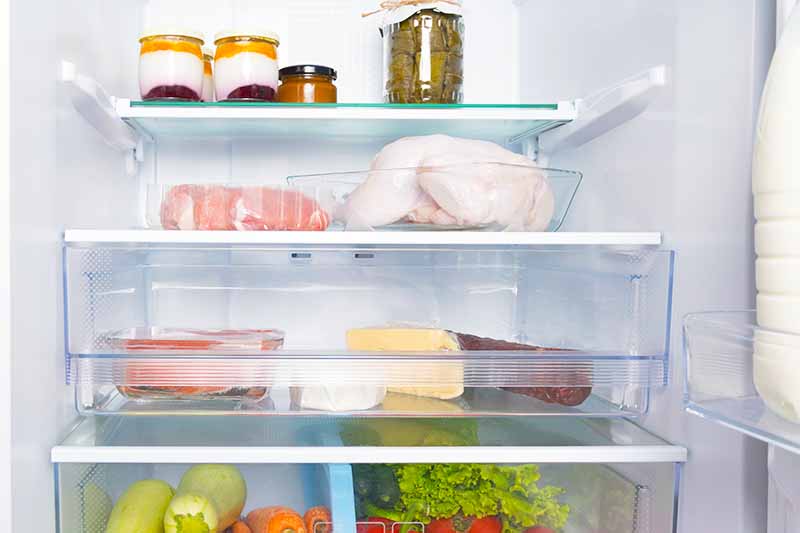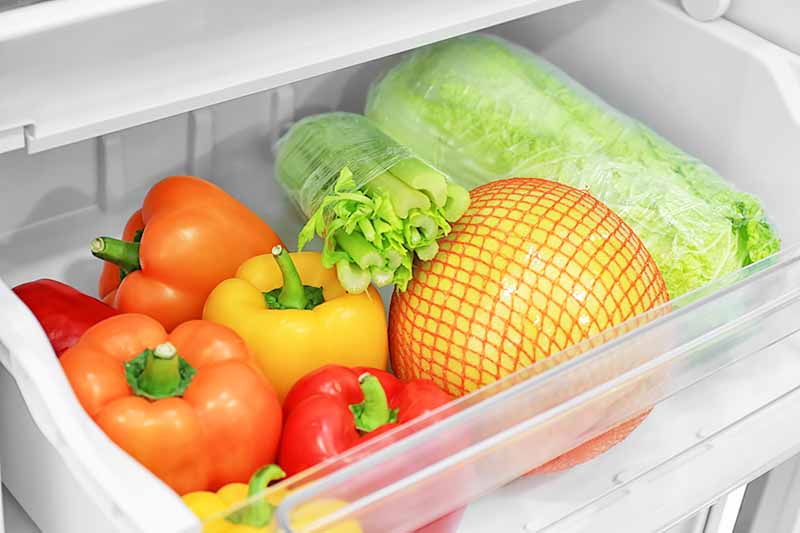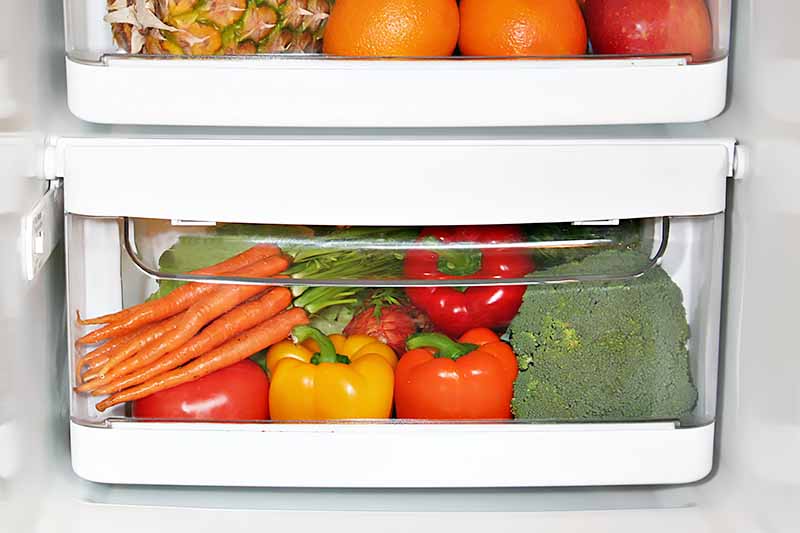Refrigerator crisper bins can quickly become catch-alls for various items we want to organize and keep from rolling around, ranging from snacks to makeup. However, when they are used as intended – to store produce! – they can help to extend the life of our fruits and vegetables.

This article discusses types of fridge crispers, ethylene emission, humidity and ventilation, and appropriate fruit and vegetable storage.
Here’s a quick preview of everything we’ll cover together:
What You’ll Learn
Types of Crispers
The typical refrigerator has side-by-side crisper bins at the bottom of the appliance.
However, smaller apartment-sized models may have one large one. And some of the latest models also have a narrow “fresh” drawer for keeping meats and cheeses as cold as possible. It’s usually located below the crisper bins, but may be above them.

Some crisper bins have a simple pull handle, and nothing more. Others also have a sliding lever that opens to permit airflow and closes to prevent it.
The printed word “Vegetables” may be written at one end, denoting that the lever should be closed for vegetable storage. The other end may signify “Fruits,” indicating that the lever should remain open for fruit storage.
When a crisper is closed to restrict airflow, it allows humidity to accumulate. A cool, high-humidity environment is best for storing fragile vegetables that are prone to wilting and some fruits that may spoil rapidly.
A vented crisper affords the option of using it open or closed. When used in the open position, air moves in and out of the bin, creating a low-humidity environment. It also facilitates the release of ethylene, a major culprit in produce spoilage. Let’s learn about it.
Ethylene 101
Some types of produce release a gaseous hormone called ethylene during ripening. Those that ripen post-harvest continue to give off this horomone and are called “climactic.” Examples are:
- apples
- avocados
- bananas
- kiwis
- mangoes
- peppers
- potatoes
- pears
- plums, peaches, and other stone fruits
- tomatoes
Other types of fruits and vegetables do not produce much, if any, ethylene, and do not continue to ripen after harvest. They are described as “non-climactic” produce. Examples are:
- blueberries
- cherries
- citrus
- eggplant
- grapes
- leafy greens
- peppers
- pineapple
- raspberries
- most types of root vegetables
Strawberries are unique because they produce ethylene while ripening on the plants, but once harvested, they produce very little and are sensitive to it. If you put apples in with your strawberries, the berries will likely ripen and spoil faster.

Similarly, an unripe banana is ethylene-sensitive and will ripen faster near apples or ripe bananas. Once a banana is ripe, it gives off ethylene which can cause other ethylene-sensitive foods to ripen and spoil more rapidly.
In addition to knowing sources of and sensitivities to ethylene gas, it’s essential to understand which produce requires high-humidity storage and which does better in a low-moisture environment.
Generally speaking, vegetables require more humidity than fruits, but there are exceptions. Let’s look at the guidelines for both high- and low-humidity storage.
High-Humidity Bin
A closed vent or ventless drawer is best for vegetables with the greatest water content that need a high-humidity setting to inhibit wilting and rotting.

Examples of produce that requires this kind of storage include:
- Leafy greens, like chard, collards, kale, lettuce, and spinach
- Fragile herbs, like chives, cilantro, dill, and parsley
- Leeks and spring onions
- Peppers
- Thin-skinned veggies, like asparagus, green beans, cucumbers, and zucchini
- Cruciferous vegetables, like broccoli and cauliflower
- Root vegetables, like beets and carrots
In addition, some fruits store best with ample moisture, including:
- Soft berries, like blackberries, raspberries, and strawberries
- Citrus, like grapefruit, lemons, limes, and oranges
When storing this style of produce, contain small foods, like berries and mushrooms, in loose mesh bags or the cardboard cartons (plastic removed) they came in to keep them from being squashed.
Avoid plastic wrappings, as they trap moisture and accelerate spoilage. If you have to wrap a cut veggie formerly stored in this bin, transfer it to the main fridge compartment where the moisture is lower.
Low-Humidity Bin
Primarily for fruit storage, a low-humidity, vented compartment is designed for produce that emits ethylene gas and is soft and prone to rotting.

Examples are:
- Blueberries
- Figs
- Grapes
- Kiwis
- Mangoes
- Ripe apples, avocados, and pears
- Ripe melons, like cantaloupe and honeydew
- Ripe stone fruits, like peaches, plums, and nectarines
- Ripe tomatoes
Once you have cut into a melon, peach, or another type of produce listed above, enclose the cut end in snug-fitting plastic wrap. It’s okay to leave the cut and wrapped item in the vented low-humidity drawer.
A Few Exceptions
To induce ripening, skip the cold storage and keep the following on the kitchen counter instead:
- unripe apples
- bananas
- avocados
- stone fruits
- tomatoes
Root vegetables like the following do best with cool, dry storage:
- bulb onions
- garlic
- potatoes
- sweet potatoes and yams
Bulb onions keep well in a single layer, not touching, on the pantry shelf, or braided as a bunch if the leaves are still attached and hung up.
A head of garlic will last for a long time in a vented ceramic garlic cellar. Multiple heads with green tops attached are easily braided and suspended from a hook.
Potatoes are ethylene-sensitive and do best in a single layer, not touching, on the pantry shelf.
Avoid storing these root vegetables together and on top of each other. Smells easily mingle, and weight and proximity may result in moisture buildup and spoilage.
Green onions and leeks are a different story. They require cold storage and are ethylene-sensitive. However, their odors may permeate a storage bin.
You can store leeks and scallions in the high-humidity drawer if you put them in a zippered plastic bag with the air squeezed out. If moisture gets into the bag, spoilage will accelerate.
Three Final Tips
Now that we know about ethylene emission, ethylene-sensitive produce, the different types of bins, and exceptions to the general rules, here are three bonus tips for successful storage:

- Before each harvest or grocery delivery, remove the contents of the drawers and clean them with a sanitizing wipe. Rinse thoroughly and dry before refilling.
- Do not wash produce before storage. Wetness jump-starts the rotting process. If you can’t stand the idea of putting dirty food in the fridge, wash it, but dry it thoroughly before putting it away.
- Fill the crisper bins no more than two-thirds full to avoid damage and excess moisture buildup that may lead to rotting.
Whether you grow your own fruits and veggies or buy them, knowing how to keep them fresh and handy when you need them is essential. Manufacturers design crisper bins with this function in mind, so make the most of them!
Want to learn more about growing your own produce at home? Visit our sister site, Gardener’s Path, for growing guides and tips.
If you found this guide informative, find more tips that you can put to use in these kitchen equipment guides:
- Foodal’s In-Depth Guide to Top-Rated Pressure Canners
- Foodal’s Ultimate Guide to Dehydrating Your Garden’s Bounty
- The Complete Countertop Grain Mill Buying Guide
© Ask the Experts, LLC. ALL RIGHTS RESERVED. See our TOS for more details. Uncredited photos via Shutterstock.
About Nan Schiller
Nan Schiller is a writer from southeastern Pennsylvania. When she’s not in the garden, she’s in the kitchen preparing imaginative gluten- and dairy-free meals. With a background in business, writing, editing, and photography, Nan writes humorous and informative articles on gardening, food, parenting, and real estate topics. Having celiac disease has only served to inspire her to continue to explore creative ways to provide her family with nutritious locally-sourced food.




